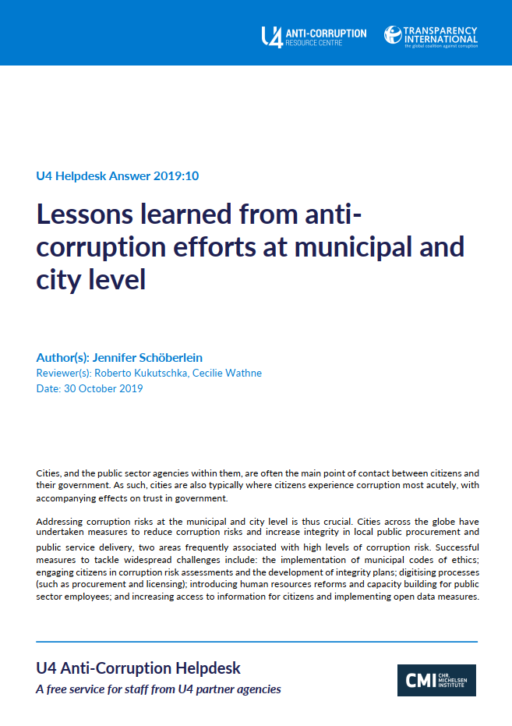- Home
- Anti-Corruption Helpdesk
- Lessons learned from anti-corruption efforts at municipal and city level
Lessons learned from anti-corruption efforts at municipal and city level

This Anti-Corruption Helpdesk brief was produced in response to a query from a U4 Partner Agency. The U4 Helpdesk is operated by Transparency International in collaboration with the U4 Anti-Corruption Resource Centre based at the Chr. Michelsen Institute.
Query
What are the lessons learned and good practices established to counter corruption at city level? Lessons learned could be from and by all actors involved, including the city administration, donors, civil society and media. Please include examples from Ukraine if possible.
Summary
Cities, and the public sector agencies within them, are often the main point of contact between citizens and their government. As such, cities are also typically where citizens experience corruption most acutely, with accompanying effects on trust in government.
Addressing corruption risks at the municipal and city level is thus crucial. Cities across the globe have undertaken measures to reduce corruption risks and increase integrity in local public procurement and public service delivery, two areas frequently associated with high levels of corruption risk.
Successful measures to tackle widespread challenges include: the implementation of municipal codes of ethics; engaging citizens in corruption risk assessments and the development of integrity plans; digitising processes (such as procurement and licensing); introducing human resources reforms and capacity building for public sector employees; and increasing access to information for citizens and implementing open data measures.
Main points
- A thorough risk assessment and context analysis are crucial to design appropriate local anti-corruption measures.
- Engaging relevant stakeholders (including citizens) in the risk assessment and design process is paramount.
- Reforms to public procurement and public services as well as access to information are among the most common and most successful measures implemented.
- Information technology greatly assists in establishing successful transparency and citizen engagement efforts, but it needs to be implemented with the consideration of local capacities.
Contents
- Introduction
- Corruption and anti-corruption at the city-level
- Successful measures and their global implementation
- Integrity plans and codes of ethics
- Public sector and administrative reform
- Increasing transparency and citizen engagement
- Conclusions and lessons learned
- References
Authors
Jennifer Schöberlein
Reviewers:
Roberto Martinez B. Kukutschka, Transparency International and Cecilie Wathne, U4 Anti-Corruption Resource Centre
Date
01/11/2019
Tags
 Download PDF
Download PDF
